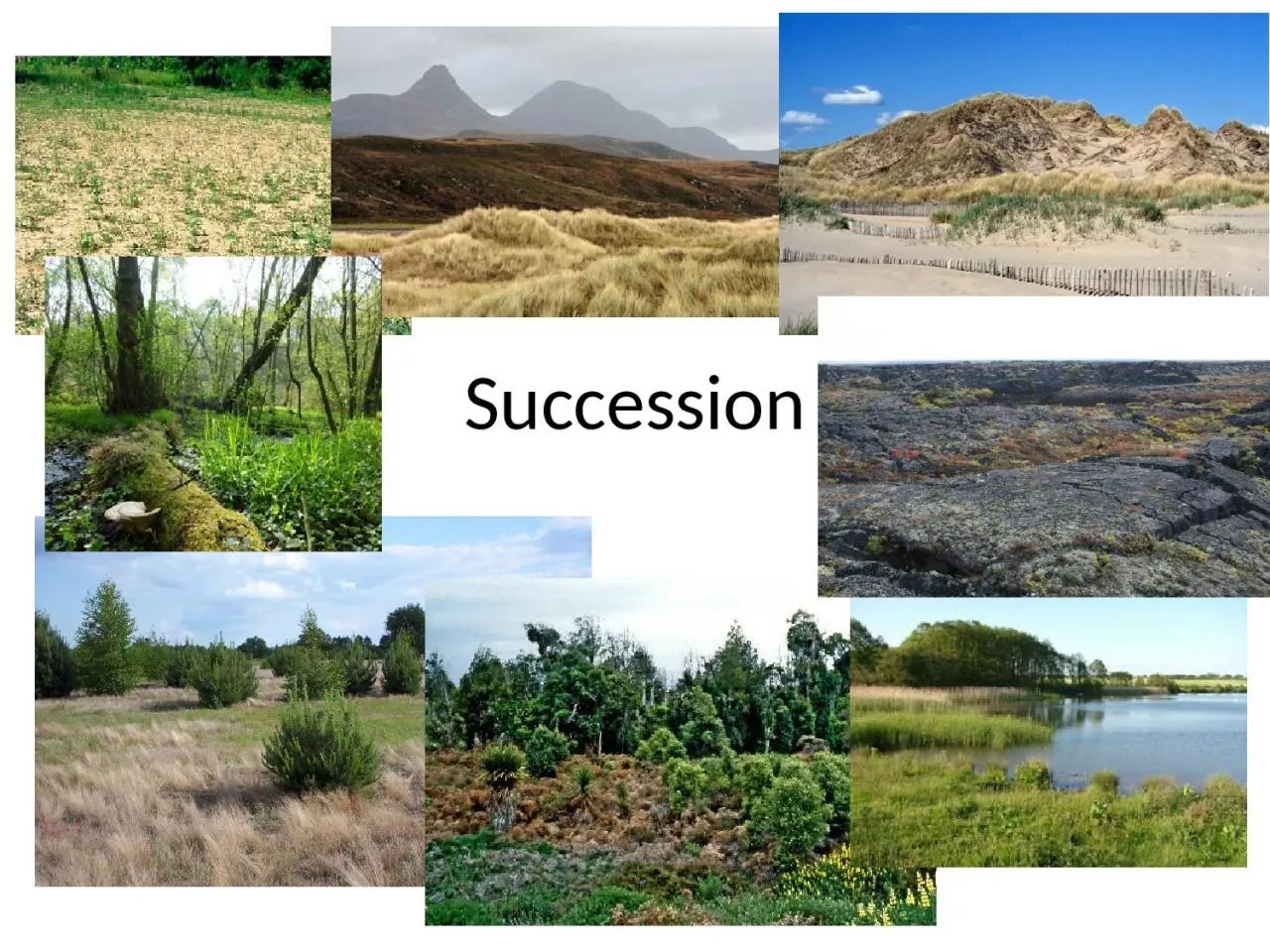

Grade Learning outcome Task DE I can define the terms succession pioneer species and climax community use the internet if necessary Write the definitions of succession pioneer species and community ID: 1026815
Download Presentation The PPT/PDF document "Succession We are looking at this sectio..." is the property of its rightful owner. Permission is granted to download and print the materials on this web site for personal, non-commercial use only, and to display it on your personal computer provided you do not modify the materials and that you retain all copyright notices contained in the materials. By downloading content from our website, you accept the terms of this agreement.
1. Succession
2. We are looking at this section of the specification:
3. GradeLearning outcomeTaskD/EI can define the terms ‘succession’, ‘pioneer species’ and ‘climax community’ (use the internet if necessary).Write the definitions of succession, pioneer species and community.CI can identify a pioneer species and put a range of organisms in the order in which they would appear in a new community.Put a range of organisms in the correct order in which they would appear in a new environment.BI can explain why organisms appear in a particular order.Create a flow chart showing how one organism would prepare the environment to enable the next one to grow.A/A*I can evaluate ways of managing habitats and conservation.Successfully answer evaluation question.To achieve the following grades, you should be able to complete the tasks below:
4. SuccessionSuccession is the gradual change in a community over time. Primary succession occurs when organisms colonize a lifeless habitat.During succession the organisms within an ecosystem change its abiotic conditions. Secondary succession occurs when organisms re-colonize a devastated ecosystem. This allows better adapted organisms to colonize the area, replacing its current inhabitants.
5. Bare rock or barren land may result from….GlaciersLakes formed due to land subsidenceSilt and mud at river estuaries
6. Colonisation by pioneer speciesWhich type of organism would be well adapted to colonising a bare, hostile (i.e. no nutrients, no shelter) environment? Discuss together and write a LIST of what the organisms would need to do. Think about:How does the organism get there in the first place (seeds, spores etc.)?What do the seeds/spores then need to do?Where do energy, carbon and nitrogen come from?Will there be shelter, water, habitats?5 minutesThe pioneer species is the first to colonise a new area.
7. SuccessionEach species in a succession changes the conditions to make it more suitable for subsequent species to survive. Each stage is known as a ‘sere’ or ‘seral stage’.Look at the animation on the next slide to see how succession occurs on a sand dune (this is also called a ‘psammosere’).
8. Sand dune succession
9. Species adaptations during succession
10. Succession on a rocky surface
11. From pioneer to climax community
12. Click the link below to watch a video about succession:http://education-portal.com/academy/lesson/ecological-succession-from-pioneer-to-climax-communities.html#lesson
13. Making use of our knowledge of successionEach seral stage of succession has distinct biotic and abiotic characteristics. It may be necessary to halt the process of succession preventing the climax community forming, in order to conserve unique species.
14. Conservation of habitatsUnlike other plants, grass leaves have their meristems at their base, allowing them to continue growing even when cut. Thus grasslands can be maintained by mowing or grazing. This can help to conserve some rare wildflower populations which are endemic to grassland ecosystems.
15. North Yorkshire Moors – the heather would not be there if the moors were not ‘managed’Heather enables grouse to breed (food and shelter)So the grouse can be shot…………..
16. Without conservation the NY moors would look like this
17. The North Yorkshire Moors are not naturally covered in heather; without human intervention they would be colonised with bracken. The moor is ‘managed’ – bracken is cleared with herbicides to enable the heather to grow. The heather is important for the grouse (they nest within the heather and young shoots provide food for their young). Heather is deliberately burnt every year to enable the young shoots to regrow. People who shoot grouse - ‘guns’ - rely on the moors being ‘managed’ so that they have a supply of grouse to shoot (shooting season begins August 12th when the baby grouse are big enough to shoot). Without the revenue from shooting the land owners could not afford to manage the land and it would revert to bracken. Evaluate the decision by the land owners to manage the land. You need to consider points for and against maintaining the heather.
18. (a) Explain the meaning of the term primary succession.....................................................................................................................................................................................................................................................................................................................................................................................................................................................................................................[2]starts with previously uncolonised area / bare ground / bare rock / AW;ref to pioneer species / named pioneer;series of recognisable, seres / stages;progresses to, climax / final equilibrium stage;
19. (b) Explain the role of pioneer plants in succession on a bare rock or sand dune.......................................................................................................................................................................................................................................................................................................................................................................................................................................................................................................................................................................................................................................................................................................................................................[3]stabilise environment;soil development / increase humus / organic material;change soil pH;hold more water;release more minerals or nutrients / increase N content or fix N / hold ions;form microhabitat / reduce exposure / provide shelter / reduce erosion;
20. The figure below shows a primary succession in a temperate climate.X represents an example of deflected succession.Suggest two ways in which deflected succession at X could be caused.[2]
21. any two from following:grazing;burning;mowing / application of fertilizer / application of selective herbicide;exposure to wind;grass able to continue to grow (linked to a statement above);
22. (d) Explain how biomass changes during a primary succession.....................................................................................................................................................................................................................................................................................................................................................................................................................................................................................................[2]increases;plants at later stages are large / plants in early stages are small;trees / shrubs. are woody, appear later in succession;
23. Answer the application question on the back of your sheet.Show all of your work to your teacher.Collect a set of exam questions.Complete the questions.